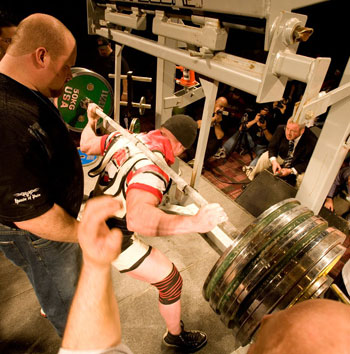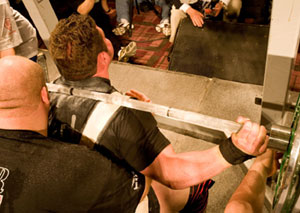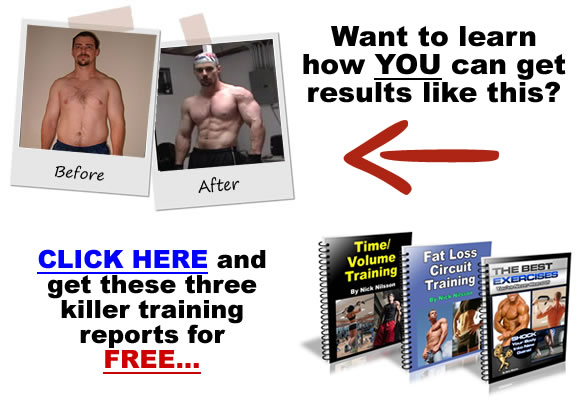|
17 Unique and Powerful Tips For Taking Your Barbell Squats
To The Next Level and Beyond!
 Known as the "King of Exercises," the barbell squat truly lives up to its name. The squat is one of the single most powerful muscle and strength building exercises a person can do.
Known as the "King of Exercises," the barbell squat truly lives up to its name. The squat is one of the single most powerful muscle and strength building exercises a person can do.
Right now, you're going to learn 17 of the most immediately useful techniques that I know for rapidly improving your squat!
1. Try wearing solid-heeled work boots when squatting. They give a natural heel elevation and allow the power from your legs to be transferred better than when wearing soft-heeled running shoes. You can lose power at the bottom when wearing soft shoes because the sole will squish in when you push. If you don't have work boots, try squatting barefoot. You will not lose any power at the bottom through soft shoes that way. When you squat barefoot, set the racking collars a little lower to make up for the lack of soles. If neither work boots nor going barefoot is an option, use court shoes. They have the most solid sole of any type of shoe.
2. If you find yourself leaning over too far as you come down to the bottom of the squat, lack of calf flexibility may be your problem. Work on that before each squat session by stretching the calves for 5 minutes.
3. Hold your hands on the bar fairly close in to your shoulders (similar to your bench press grip width) and keep your elbows pointed DOWN through the entire squat. If you hold the bar too wide, this will force your shoulders to rotate internally (forward). Your elbows will start to point backwards, which will cause the bar to rotate forward as you come down. As the bar rotates forward, this will cause you to lean over excessively, increasing the pressure on L4 and L5 of the lumbar area of your lower back. Keeping your elbows pointed down activates your external rotator muscles (the muscles in the shoulder area that pull backwards) which will keep the bar from rolling forward.
4. If you feel yourself leaning over and pushing from the forefoot area too much, use pressure from your hands to rotate the bar backwards. This will force the weight back over your heels, improving your balance and posture while working the quads better and preventing injury.
5. If you feel you are about to get stuck at the bottom, try this trick: yank down hard on the bar as though trying to snap it in half over your back. It may sound counterproductive but if you do this while you are straining against the bar, it will cause an emergency stretch reflex in your quads and give you an extra little kick out of the bottom of the movement.
6. As you start down into the squat, your knees should bend first, followed closely by the trunk. Most people descend with the glutes leading, followed by the knees. This emphasizes the back and glutes rather than the thighs.
 7. Look slightly up and forward. If you look down, your head will go forward. Here's the problem: your lumbar (lower back) area mimics your cervical (neck) area with positioning. If your neck is flexed forward (as when looking down), your lumbar area will try to flex to match it (when it should be extended and held tightly in an arched position).
7. Look slightly up and forward. If you look down, your head will go forward. Here's the problem: your lumbar (lower back) area mimics your cervical (neck) area with positioning. If your neck is flexed forward (as when looking down), your lumbar area will try to flex to match it (when it should be extended and held tightly in an arched position).
8. To help get the proper position at the bottom of the squat, try to squeeze your elbows together behind your back, arch your lower back and look up slightly. This will force your back into the proper position as well as giving your rear delts and back a good workout.
9. Some people squat with their heels raised. Try the opposite, squatting with your toes raised. You will need to thoroughly stretch your calves out to do this one but it will force you to push only with your heels, maximizing hamstring and glute involvement as well as focusing on the lower quads. Perform this technique with high rep and using a full range of motion to increase blood flow to the lower quads. Be sure not to raise the toes up excessively (a thin plate such as 5 or 10 will do it).
10. To increase quad involvement, pull your toes up to touch the top of the insides of your shoes. This will tend to throw the point of push back to the heels.
11. Do not use a belt when squatting. At the start, suck in your gut and hold it tight, activating the transverse abdominus muscle (the internal supporting muscles of the core), giving you a natural weight belt. Tightening the muscles like this will increase intra-abdominal pressure, just like a weight belt does. A weight belt causes dysfunction and weakness of the transverse abdominus and can lead to injury. The belt inhibits the body's ability to fire the muscle when needed and can predispose the back to injury by creating a weakness in those important supporting muscles.
An important point to note here is that if you've always used a belt for squatting, work back up to heavier weights slowly. Start with lighter weight and higher reps to give your supporting muscles a chance to work and strengthen. If you jump right into heavy weights without re-training your core muscles, you could injure yourself. Focus on sucking in tightening the abs and feeling them contract and hold during the squat.
12. To fire the lower quads during squats, as you descend, come up on your toes in a calf raise. Stay upright and sit back. Only go to parallel on this trick. Do not lose tension in the quads and only do this with a very light weight. It can be tricky to balance with this one so take it easy when first trying it. Don't let your knees drift forward too much and don't lean over. This will also give a great contraction in your calves.
13. A plastic molded device called the Manta Ray is an excellent tool for squatting. There is no pain from the bar as the weight on the bar is more evenly distrubuted across the entire shoulder girdle instead of having the bar digging into the shoulder blades. It is also much safer than a rolled up towel or pad as the bar cannot roll.
 14. Build power in the bottom of the squat by performing the Wall Sit exercise after every leg workout. This is a good way to strengthen your thighs isometrically (without moving). Go into a sitting position with your back against a wall, lower back arched, knees bent at 90 degrees, and just hold it there for as long as you can, pushing yourself backwards into the wall to keep yourself up in position. This helps you build power in the bottom of the squat. You can increase the resistance by holding a dumbell or weight plates on your lap (you can even have a spotter progressively pull plates off your lap as you get tired!).
14. Build power in the bottom of the squat by performing the Wall Sit exercise after every leg workout. This is a good way to strengthen your thighs isometrically (without moving). Go into a sitting position with your back against a wall, lower back arched, knees bent at 90 degrees, and just hold it there for as long as you can, pushing yourself backwards into the wall to keep yourself up in position. This helps you build power in the bottom of the squat. You can increase the resistance by holding a dumbell or weight plates on your lap (you can even have a spotter progressively pull plates off your lap as you get tired!).
15. Try Bottom Start Partial Squats - this variation is done in a power rack. Set the pins just above where the bar would be at the low point of your regular squat. This is where you will be starting the movement from. This will build tremendous power out of the bottom of the squat. Do not bounce in this position! Set yourself up under the bar in the bottom of the squat position then gradually build up tension in your legs and body. When you're ready, explode the weight up a few inches. Lower yourself back down under control. You will need to experiment with the amount of weight you use to get an idea of where to start.
16. Typical Squat Problems and Solutions
*Heels rise - keep your eyes up, chest up, lean back slightly.
*Rounded back - strengthen your lower back, arch your lower back more, lift your toes up in your shoes while you squat, grip the bar closer to your shoulders.
*Lack of depth - open your stance, turn your toes out up to 30 degrees (remember to keep your knees tracking straight over your toes).
*Knees buckle in - wrap a weight belt around your thighs and pressout against the belt as you come up.
*Excessive leaning over - stretch your calves thoroughly, squat withyour heels raised (use a wooden wedge or ten-pound plates). It is better to stretch, though, as squatting on blocks is not the best way to squat. Hold the stretches for 3 to 5 sets of 15 seconds using the standing calf raise or seated calf machines or any other good calf stretch. Work on improving your calf flexibility in the long-term as well, stretching a lot when you work calves.
17. Don't use the Smith Machine to squat. The Smith Machine, while making the squat easier to balance, is not better for squatting. It is hard on the patellar tendons of the knees due to the shearing forces involved. It is bad for the ACL (anterior cruciate ligament) and it also takes the hamstrings and stabilizing muscles out of the movement. The Smith Machine squat is especially bad when you set your feet a little forward of the bar and push backwards against it as you come up. Every rep will grind on your knees.
Conclusion:
Take these squatting tips to the gym with you and put them to work. You'll notice a big difference in how you squat and how much weight you can use!

More Articles by Author Nick Nilsson
Return To Weight Lifting Articles Archive
|